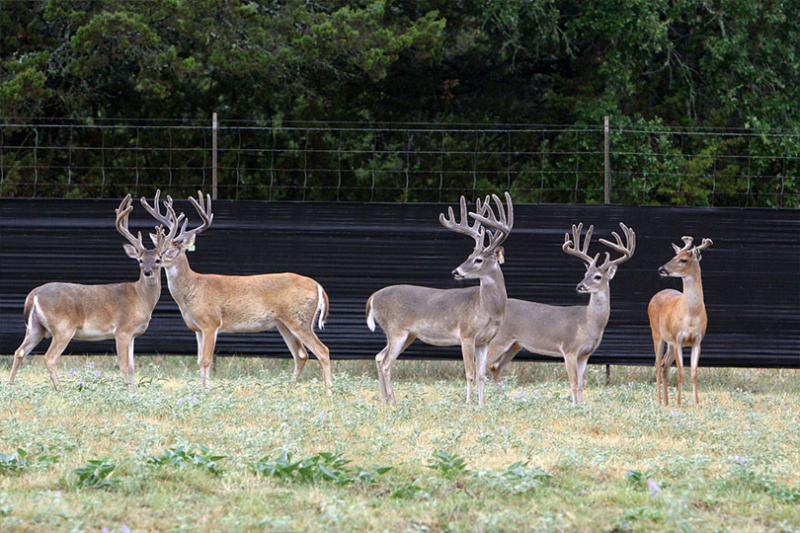By Jessica Domel
Multimedia Reporter
Newer testing and genomic predictions could be key in curbing the spread of chronic wasting disease (CWD) in both captive and wild deer populations.
The Texas Parks and Wildlife Commission recently heard from experts about what CWD is, how it is spread, what can be done to curb the spread and other research on the fatal, neurological deer disease.
Dr. Chris Seabury, professor of genomics at the Texas A&M School of Veterinary Medicine and Biomedical Sciences, discussed a custom tool he designed that can be used to predict a deer’s CWD risk.
“CWD risk and the incidence of CWD can be predicted with high accuracy regardless of the origin, whether it’s through infectious exposure, the normal classical route or whether it’s sporadic,” Seabury said. “We do think sporadic cases can happen. They happen in other species.”
Seabury’s research looks at a white-tailed deer’s genetics to determine the likelihood the deer could be susceptible to CWD if it is exposed to the disease.
Using that information, Seabury said the deer breeding industry could breed deer resistant to CWD.
“Selective breeding significantly reduces CWD susceptibility. That can be tested as a hypothesis and proven to be true,” Seabury said. “Total breeder depopulation is often unnecessary. We have a demonstration project. We’ve already shown that to be true.”
The pilot project is a deer breeding facility in South Texas that had a positive CWD case in 2021.
Instead of being depopulated, the buck that tested positive and the deer that came into contact with it were euthanized. The other deer remained to be tested.
Seabury said the accuracy of using his method to blindly predict which deer from a CWD positive facility will test positive averages 81%.
Although the initial application of the technology would help captive deer populations, the ability to breed less CWD susceptible deer could help free-ranging deer in the future.
The commission also heard about a second-generation test that would enable deer breeders and state officials to better detect CWD in live or deceased deer.
It’s called the Real-Time Quaking Induced Conversion (RT-QuIC) test, and it was developed in 2007 for Creutzfeldt-Jakob Disease (CJD), a human prion disease.
“Many labs have independently confirmed RT-QuIC accuracy in both human and animal prion diseases,” Dr. Peter A. Larsen, assistant professor in the College of Veterinary Medicine at the University of Minnesota, said. “The test is so sensitive that you could take one tablespoon of these (for example, a CWD prion) and mix it in 400 Olympic size swimming pools that have these (regular proteins) in it. That test could pick that up. That’s how sensitive it is.”
The test can be used to detect CWD in venison, skin, mucus, blood, urine, semen, feces, water, soil, plants, insects and sentinels.
“If you catch it super early and you live test, you could cull the animal and then go into monitoring with the sentinels and see if you effectively got in front of the situation,” Larsen said. “The caveat with all of this, if you go into an operation where CWD has been cooking for too long, you’re not going to get in front of it. It’s too late.”
Larsen said the future of CWD management is in breeding less susceptible animals through genetics, pre-movement live testing with disposable tools and real-time sentinels-based surveillance.
For low-fence operations and free-ranging deer, increased testing—including hunter-harvested deer and road kill—is important.
“You can leverage these technologies like RT-QuIC in different ways to find those prions in different scenarios,” Larsen said. “Parks and Wildlife is already doing a great job of this with management zones, but you really have to keep the pressure on. You have to cull.”
Research is underway on scrapes and mineral licks that are used by more than one deer.
“Because the deer are congregating in those areas, you can take environmental samples from those and see whether or not CWD is in the region. Then you know that you need to pivot and maybe focus your culling efforts in those regions,” Larsen said. “With all the feeding that goes on, not just in Texas, but throughout the U.S., you can leverage that with these sentinels to see if you have hotspots on a ranch, or in a wild scenario that you can go in and discover and then target and cull those.”
Teams in the U.S. and South Korea are developing methods to remediate the environment where CWD prions, which can spread the disease, exist to stop it from spreading to uninfected animals.
“I understand how complex it is in a wild situation. Within the fence, it’s a little bit more contained, but it’s still complex,” Larsen said. “I do think that there are ways that we can take, or new avenues that we can explore to remediate the environment, but bottom line is there’s no easy answer with CWD.”
Larsen and Seabury’s presentations, along with the other presentations, can be seen in full on the TPWD YouTube channel.


Leave A Comment